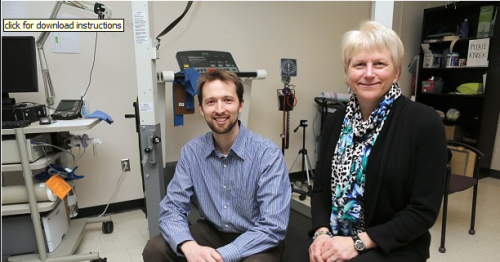High-intensity interval training benefits chronic stroke patients

High-intensity interval training is a promising rehabilitation strategy for chronic stroke patients and may be superior to the current guidelines of moderate-intensity continuous exercise, new research from the University of Cincinnati (UC) shows.
The research was presented Wednesday, Feb. 11, at the American Heart Association/American Stroke Association (AHA/ASA) International Stroke Conference 2015 in Nashville, Tennessee. Pierce Boyne, PT, DPT, NCS, a doctoral student and research assistant professor in the UC College of Allied Health Sciences' Department of Rehabilitation Sciences, is the study's lead author and project director.
Co-authors included Kari Dunning, PT, PhD, an associate professor in the Department of Rehabilitation Sciences, and Brett Kissela, MD, MS, Albert Barnes Voorheis Chair of Neurology and Rehabilitation Medicine in the UC College of Medicine and a member of the UC Neuroscience Institute. They are Boyne's mentors and were the principal investigators on two pilot grants that funded the project, which also included collaborators from Cincinnati Children's Hospital Medical Center and the College of Medicine's Department of Internal Medicine.
Current AHA/ASA post-stroke guidelines recommend moderate-intensity continuous exercise to improve aerobic fitness, mobility and cardiovascular health. High-intensity interval training differs from moderate-intensity continuous exercise by augmenting exercise intensity with bursts of concentrated effort alternated with recovery periods.
"In patients in the chronic stage of stroke recovery (six months or longer post-stroke), aerobic deconditioning is a major barrier to recovery," Boyne says. "We wanted to make a preliminary assessment of the comparative efficacy of high-intensity and moderate-intensity continuous exercise for improving aerobic capacity and walking function in chronic stroke."
Previous research has shown that high-intensity interval exercise is more effective than moderate-intensity continuous exercise for improving aerobic capacity among healthy adults and persons with heart disease. However, he says, no previous study has compared the two among persons with stroke.
Boyne and colleagues from the College of Allied Health Sciences Department of Rehabilitation Sciences, the UC College of Medicine's Departments of Internal Medicine and Neurology and Rehabilitation Medicine and Cincinnati Children's Hospital Medical Center recruited 16 subjects with residual gait impairment from stroke, all of whom passed a treadmill stress test prior to enrollment in the study. They were randomized to high-intensity interval training or moderate continuous exercise for 25 minutes, three times a week, for four weeks.
The high-intensity interval group alternated 30 seconds of maximum tolerated treadmill speed with 30- to 60-second rest periods. The moderate continuous exercise group did continuous treadmill walking at 40 to 50 percent heart rate reserve. Outcomes were measured pre- and post-training by a blinded rater who assessed peak oxygen uptake, aerobic capacity, energy cost of walking, floor walking speed and treadmill walking speed.
Subjects in the high-intensity interval group showed significantly greater improvement in aerobic capacity and treadmill speed, Boyne says, with at least moderate improvement in the other categories. The moderate-intensity group showed essentially no change in the same time period, indicating that exercise intensity may be a key factor.
"These results show that high-intensity interval exercise is a potent intervention for improving aerobic capacity and walking function in chronic stroke," Boyne says. "This is extremely promising because these changes occurred in just four weeks of training. However, further study with a larger sample is needed."



















